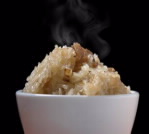EMBARGOED FOR RELEASE | May 29, 2010
Revealing the ancient Chinese secret of sticky rice mortar
WASHINGTON, May 29, 2010 — Scientists have discovered the secret behind an ancient Chinese super-strong mortar made from sticky rice, the delicious “sweet rice” that is a modern mainstay in Asian dishes. They also concluded that the mortar ― a paste used to bind and fill gaps between bricks, stone blocks and other construction materials ― remains the best available material for restoring ancient buildings. Their article appears in the American Chemical Society (ACS) monthly journal, Accounts of Chemical Research.
Bingjian Zhang, Ph.D., and colleagues note that construction workers in ancient China developed sticky rice mortar about 1,500 years ago by mixing sticky rice soup with the standard mortar ingredient. That ingredient is slaked lime, limestone that has been calcined, or heated to a high temperature, and then exposed to water. Sticky rice mortar probably was the world’s first composite mortar, made with both organic and inorganic materials.
The mortar was stronger and more resistant to water than pure lime mortar, and what Zhang termed one of the greatest technological innovations of the time. Builders used the material to construct important buildings like tombs, pagodas, and city walls, some of which still exist today. Some of the structures were strong enough to shrug off the effects of modern bulldozers and powerful earthquakes.
Their research identified amylopectin, a type of polysaccharide, or complex carbohydrate, found in rice and other starchy foods, as the “secret ingredient” that appears to be responsible for the mortar’s legendary strength.
“Analytical study shows that the ancient masonry mortar is a kind of special organic-inorganic composite material,” the scientists explained. ”The inorganic component is calcium carbonate, and the organic component is amylopectin, which comes from the sticky rice soup added to the mortar. Moreover, we found that amylopectin in the mortar acted as an inhibitor: The growth of the calcium carbonate crystal was controlled, and a compact microstructure was produced, which should be the cause of the good performance of this kind of organic-organic mortar.”
To determine whether sticky rice can aid in building repair, the scientists prepared lime mortars with varying amounts of sticky rice and tested their performance compared to traditional lime mortar.
“The test results of the modeling mortars shows that sticky rice-lime mortar has more stable physical properties, has greater mechanical strength, and is more compatible, which make it a suitable restoration mortar for ancient masonry,” the article notes.
###
ACS’ Accounts of Chemical Research
“Study of Sticky Rice-Lime Mortar Technology for the Restoration of Historical Masonry Construction”
Media Contact:
Michael Bernstein
202-872-6042
Michael Woods
202-872-6293


